
12 minute read
Pioneer Push
We take the first Australian-made electric truck, the SEA300, for a zero-emissions journey through the Dandenong ranges

Words Cobey Bartels | Images Sean Lander

See the video @ TradeTrucks.com.au

unfamiliar What is is the whir
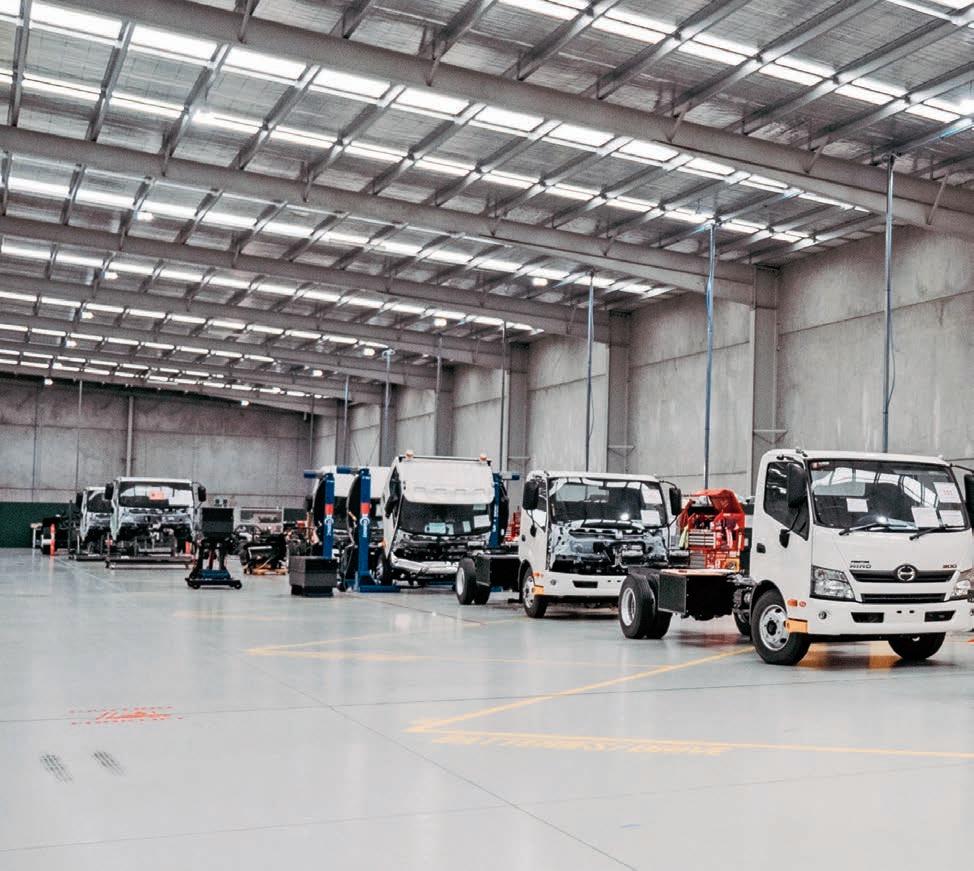
The SEA Electric production line, free of fossil fuels and spotless across all six work bays
he buzz around electric vehicles continues to intensify, introduced to the masses by the likes of Tesla and now catapulted to the forefront of T political-economic interest as traditional vehicle manufacturers race to snag a piece of the pie. Truck makers have only dipped their toes in the burgeoning electric market until now, with Fuso’s light-duty eCanter doing the rounds, while light through to heavy manufacturers are forming electric-focused alliances in a bid to hasten progress. There’s a new kid on the block, though, who’s beaten the big players to the party – global e-mobility outfit SEA Electric. Headquartered in Los Angeles, it is building trucks locally out of Dandenong in Victoria. While the manufacturer has been making moves on the scene since 2013, it’s not until recently that it has offered a production-ready SEA-branded electric truck for the Australian market.
After seeing SEA Electric’s latest offerings at the Brisbane Truck Show, we shot down to the factory in Dandenong for a look at how these trucks come together, managing to score the keys to a freshly built SEA300 for the day.
ENTER THE BUILD
The in-house developed powertrain, dubbed SEA-Drive, has been retrofitted to a variety of commercial vehicles in recent years, but now powers the latest range of locally-built light- and medium-duty trucks.
A smart partnership with Hino has allowed SEA Electric to import semi-knockeddown (SKD) kits to Australia, which form
the backbone of the SEA-branded trucks. Another perk of the SEA Electric partnership with Hino is a country-wide network of 15 Hino dealers offering sales, servicing and support to customers.
For those questioning whether these are just a drivetrain-swapped Hino, the SEA Electric trucks are badged ‘SEA’ with their own unique VIN numbers.
Both Hino 300 and 500 chassis and cabs arrive straight from Japan in SKD form, where they’re swiftly assembled into the end product, the SEA300 and SEA500.
Battery packs sit where the engine and gearbox would normally take up space, feeding juice to an electric motor that supplies drive straight to the diff. It’s a simple, direct-drive system with no gearbox needed.
The facility operates like any modern factory, with six production bays and three finishing bays that spit out an Australianmade electric truck every 120 hours.
However, within the factory there is also the capacity to develop and test new products and components – an efficient use of a relatively small space.
“We have marketing, sales, design, research and development, procurement, material handling, fabrication, assembly and testing all done in-house,” explains SEA Electric vice president, operations – Asia Pacific, Glen Walker.
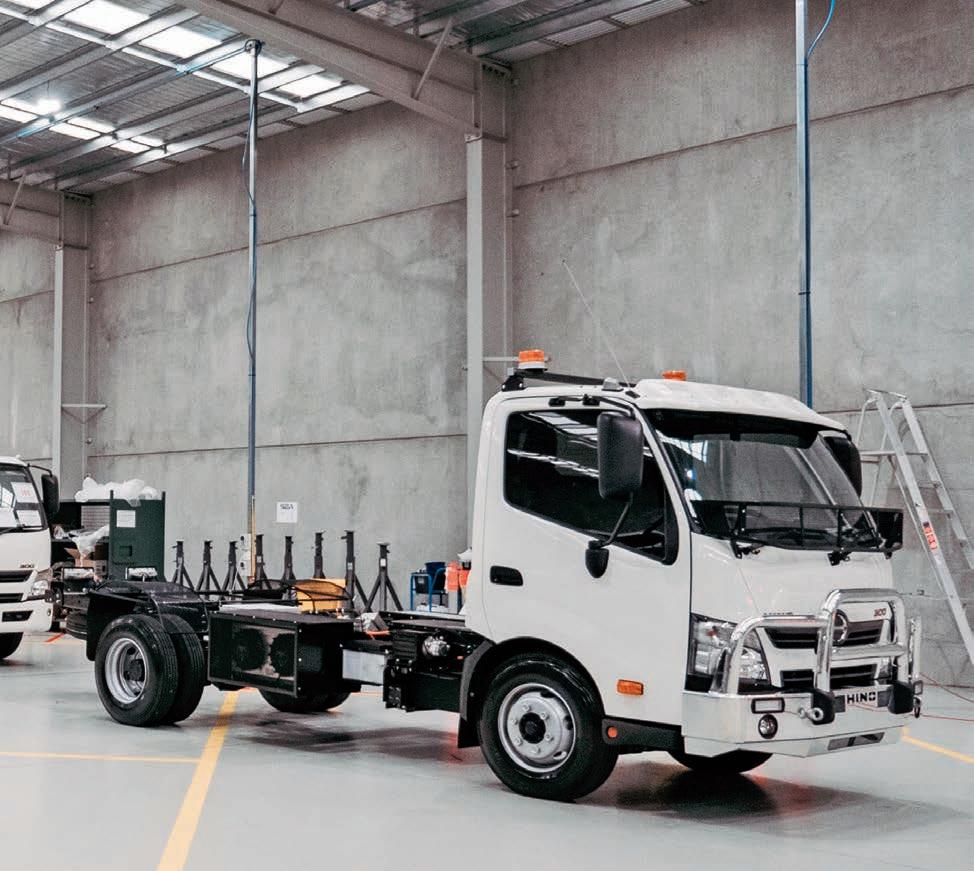
THE DRIVE
Before we pulled out from the factory, with a plan to hit the Dandenong Ranges for a strap, we were given a rundown of the

The complete Hino cabs arrive from Japan, before they’re attached to a chassis during the 120-hour build process truck from the SEA Electric team. Firing it up is no different to any truck, with a turn of the key, but what is unfamiliar is the whir as the electric motor prepares to spin up.
The existing Hino 300 interior remains largely unchanged, although some of the factory gauges like fuel and temperature have been disconnected and we’re told they will be removed altogether from future models.
All battery range and power use data is displayed on the centre infotainment screen, but can still be switched over to radio or other multimedia displays.
Selecting ‘drive’ is done using the same button pad that those who have driven this truck’s Hino cousin will be familiar with, and from there it’s just matter of ‘go and stop’.
Why the Dandenong Ranges? Why not. We were only able to get our hands on a freshly assembled cab-chassis so, without a load on the back, urban testing seemed no more appropriate than a scenic drive.
The SEA-Drive power system ranges in output depending on truck configuration, from 4,500kg to 22,500kg gross vehicle mass (GVM), but the medium wheelbase SEA 30085 we tested produces 125kW and 1,545Nm out of a 100kWh battery setup, offering an unladen range of up to 250km.
Tare weight on the medium wheelbase SEA 300-85 is 3,062kg. With a GVM rating of 7,995kg, this allows a fairly competitive payload of 4,993kg, depending of course, on the body fitted.
Make no mistake, this SEA300 steers, rides and feels identical to a Hino 300, which is hardly shocking given the underlying architecture used. However, from the
servicing How much isn’t done

moment you take off, there are two distinct differences: acceleration and braking.
It’s an odd feeling, really, having to remind yourself you’re in a truck. The acceleration is car-like and effortless, with the lack of momentary drive loss associated with gear shifts making for butter-smooth power delivery.
SEA Electric didn’t set out to build a performance vehicle and it won’t be used as such, but by truck standards this sets a new benchmark in terms of acceleration from a standstill.
Speaking of outperforming a diesel counterpart, the regenerative braking made up for improvements in acceleration, all while refilling the figurative fuel tank.
Like a traditional exhaust brake, flick the left hand stalk down and you’ve got a twostage regenerative braking system. The braking was probably the biggest departure from combustion engine normality when first driving this truck, as it pulls up with phenomenal force.
Beyond seldom having to use the service brakes we were having to actually accelerate up to stop signs and red lights downhill, it was that good.
You’ve got every reason to want to use the regenerative braking on an electric vehicle, too, as it feeds energy back into the batteries – which is all displayed on the infotainment display and becomes quite addictive to watch.
“Under braking, a diesel doesn’t produce more fuel, it disperses energy by generating heat. What we do with regenerative braking is if the motor is able to produce 1,500Nm of

Having an electric motor and batteries means easier maintenance
The heart of a SEA300 – motor up back, fed by battery packs where the motor and gearbox would ordinarily sit
A SEA Electric battery pack, assembled and ready to power a truck
The SEA Electric interface displays speed, range, charge, and power both expended and regenerated as you drive torque back into the diff, it’s able to produce up to that same torque to slow the vehicle down,” Walker says.
“Instead of generating heat, we generate energy back into the batteries to offer additional range and it also doesn’t make any noise at all.
When discussing the on-road differences between the SEA300 and the Hino 300 it’s based off, Walker points out the difference is all in the powertrain and its aim is to do the same job more efficiently.
“The truck is designed to perform the job that any truck does, so we’ve tried to make this vehicle perform as well as, if not better than, the diesel,” Walker says.
“We already know they’re quieter, there’s less vibration, there’s less fatigue and we know the power delivery is much smoother than a diesel.
“We’ve proven they efficiently cart freight, all five tonnes of it, just like a diesel.
Arguably the biggest drawcard for the SEA300 over conventional diesel truck options, is the complete and utter lack of noise.
To think that the absence of noise is more of a draw card than braking and acceleration surprised us, too.
Simply put, It’s a relaxing place to be and produces no noise pollution – two things not traditionally associated with running a truck.
“There’s a lot of curfews placed on certain applications; you can’t deliver your freight to a suburban facility between certain times of night,” Walker says.
THE DAMAGE
At this stage, SEA Electric isn’t willing to disclose specific pricing due to the countless build specifications being delivered, though these trucks are, unsurprisingly, rumoured to come in at a higher price-point than the diesel equivalents they’re based off.
SEA Electric offers a three-year/150,000km warranty period and SEA Assist 24-hour roadside assistance for the life of the warranty, provided by NTI.
Servicing is undertaken at intervals in line with those of the Hino 300, although that’s


more to take care of periodic maintenance of brakes, suspension and chassis. “Much of our vehicle servicing is standard suspension, you can’t avoid that,” Walker says.
The electric motor and batteries are relatively maintenance-free when looking at the servicing of these trucks – estimated to be good for a decade or more of daily use.
“An easier question to answer is, ‘how much servicing isn’t done’, when compared to a diesel,” Walker says.
“If you start with a diesel you’ve got fluids and filters, oils and the like.
“You’ve got adjustments and belts, you’ve got exhaust systems and cooling systems.
“Apart from checking electrical connections and making sure the fluid is circulating the motor, there isn’t much more to do – you don’t pull it apart to replace rings or rebuild one of our motors.
“It’s mainly looking at high and low voltage cabling. Checking routing and connections.
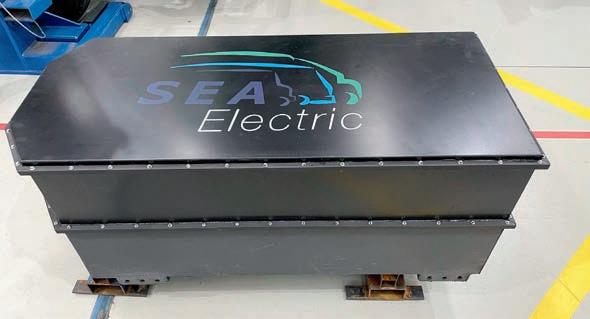
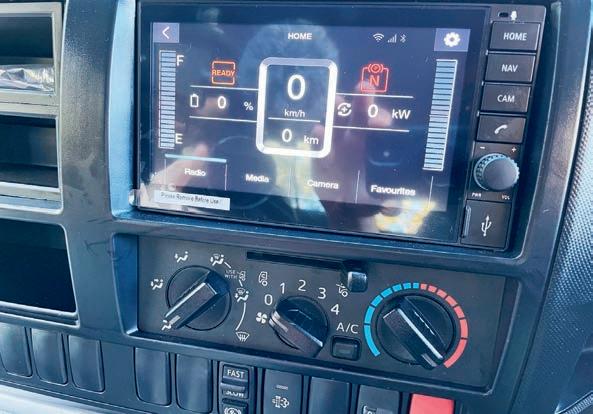
Sweet Short'n'
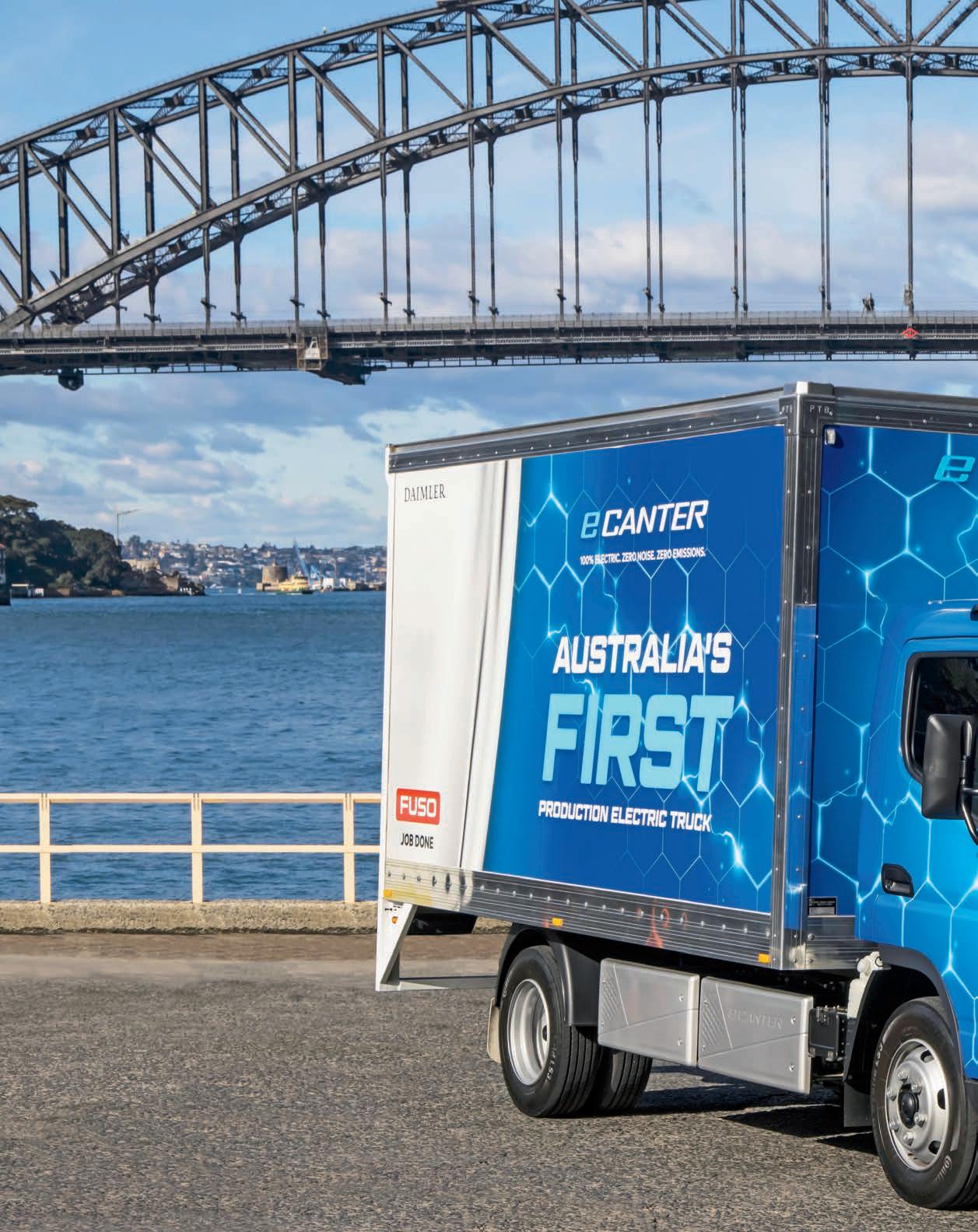
It is becoming increasingly apparent that electric trucks are the future for local delivery work and right now, Fuso’s eCanter is at the forefront of this emerging revolution in urban freight movement. Still, the onus is entirely on suppliers such as Fuso and its Daimler masters to prove the worth of their electric candidates. That might be easier said than done
Words | Steve Brooks
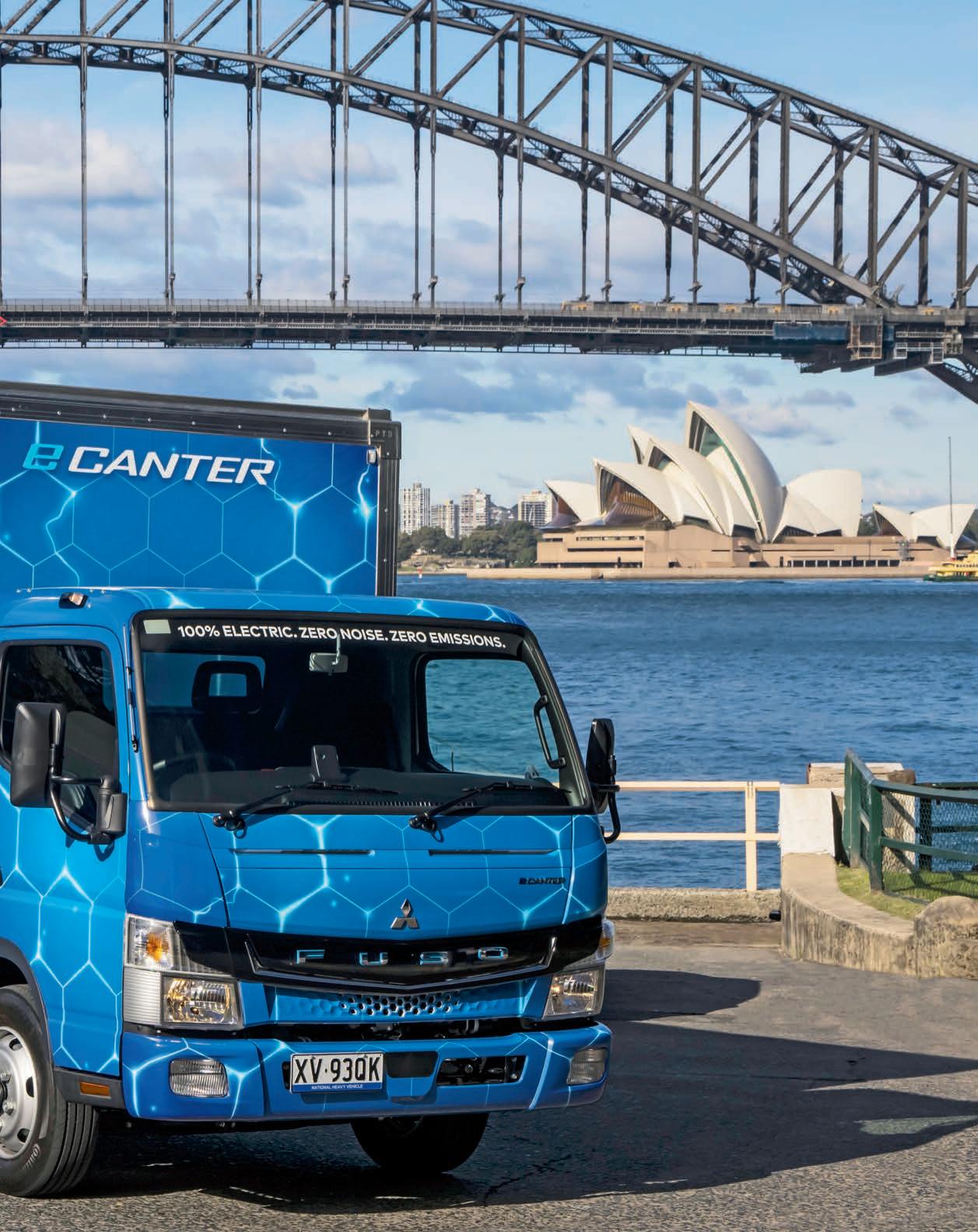
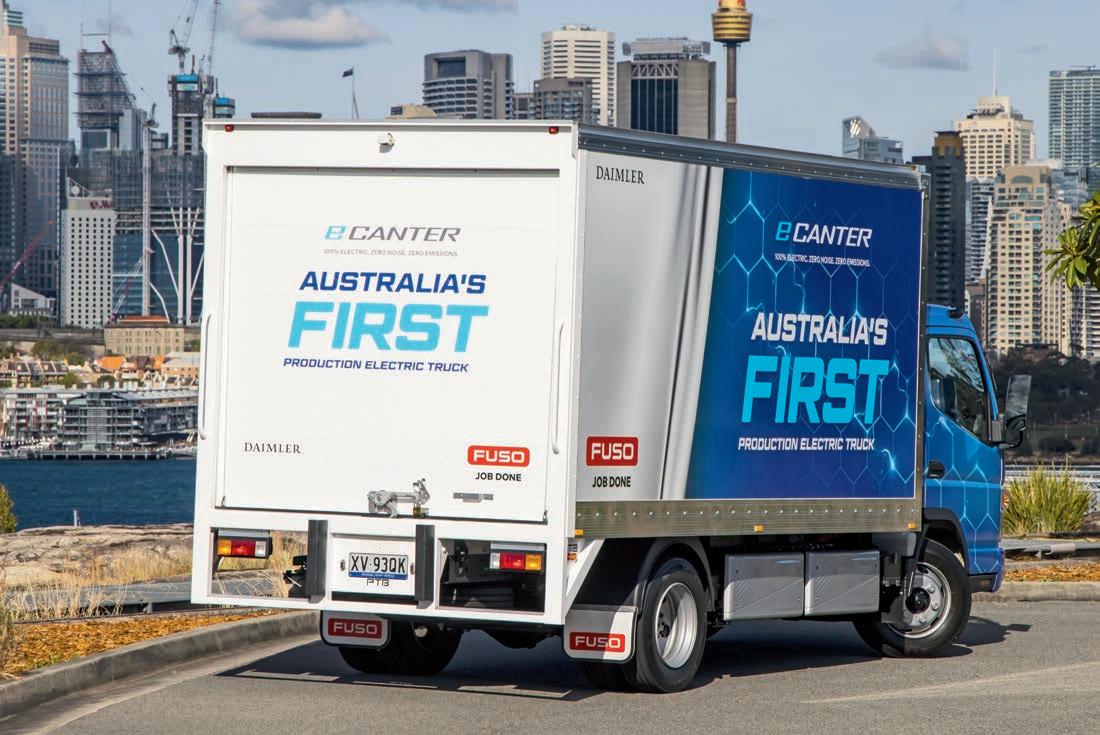
The eCanter has a laden distance of 100km on full charge
ometimes, things just don’t go the way you expect. Like, it was supposed to be a simple, short suburban drive of Fuso’s recently released electric eCanter in S Sydney’s west. A refresh, of sorts, of what we’d already experienced in previous stints, first in a Japanese prototype on Fuso’s test track and then, in late 2019, behind the wheel of an early evaluation unit through the streets of Melbourne. What wasn’t expected, however, was that the Sydney stint would be quite so short. Someone, apparently, had forgotten to flick the switch the night before and, rather than a full charge, the dash ‘distance predictor’ said there was only 58km worth of charge in the batteries rather than the reported ‘full charge’ potential of 100km. Still, it was at least a worthwhile exercise to some extent. Fuso’s claim is that eCanter’s driving range is determined on carrying a full load at the vehicle’s gross vehicle mass of 7.5 tonnes. In effect, the 100km range is the minimum distance potential operating at near or close to full load. It’s reasonable to accept Fuso’s claim for the simple reason that as a local delivery truck goes about its daily workload, it loses weight as freight progressively comes off. Thus, actual driving range is probably greater than 100km.
As soon revealed, the same reasoning can be applied to a partially charged range potential of, let’s say, 58km.
From Fuso’s Huntingwood dealership in western Sydney, and with gross weight at 6.5 tonnes, the demo truck was poked into a typical suburban slurry of baulking traffic, traffic lights and congestion. Nonetheless, all the good things we’d come to expect of the electric Canter from previous drives were again there to be appreciated, not least the realisation that driving a local delivery truck in metro mayhem just doesn’t get any easier than this.
Sure, it takes a little while to come to grips with the fact that, other than the radio, there’s basically no noise apart from the drone of rubber on the road. But the big thing is the smoothness of a truck with no engine and no transmission other than an electric motor driving into a single-speed diff. At first, you’re waiting for gearshifts that never come but it doesn’t take long to settle into the sensation of completely uninterrupted progress from go to whoa, and whoa to go.
What’s more, acceleration is stunningly brisk for a light-duty truck while at the other end of the performance spectrum, retardation through a two-stage regenerative braking system is incredibly strong.
Like its diesel counterparts, though, the
more you push the ‘go’ pedal, the more fuel (battery charge) you consume and it definitely pays to drive conservatively to maximise range.
Speaking of which, it didn’t take long to consume 58km-worth of battery charge and with the trip meter showing 57.6km and the truck’s range gauge almost on nil, it’s fair to suggest the eCanter slid back into the Huntingwood site with very little left in the tank, so to speak.
Of course, driving range remains eCanter’s Achilles heel but, as we’ve commented before, when this pushes out to 200km and more as it most surely will given the pace of developments in battery technology and electric propulsion – notably with the inclusion of hydrogen-based fuel cells to increase driving range – a whole new level of acceptance and appreciation will come into play.
Likewise, recharging systems and infrastructure are key elements that will take time and commitment from many institutions to reach satisfactory levels for commercial vehicles but, given the economies of scale in the density of major cities, demand will drive investment. As it always does.
Critically, though, someone needs to remember to flick the switch.
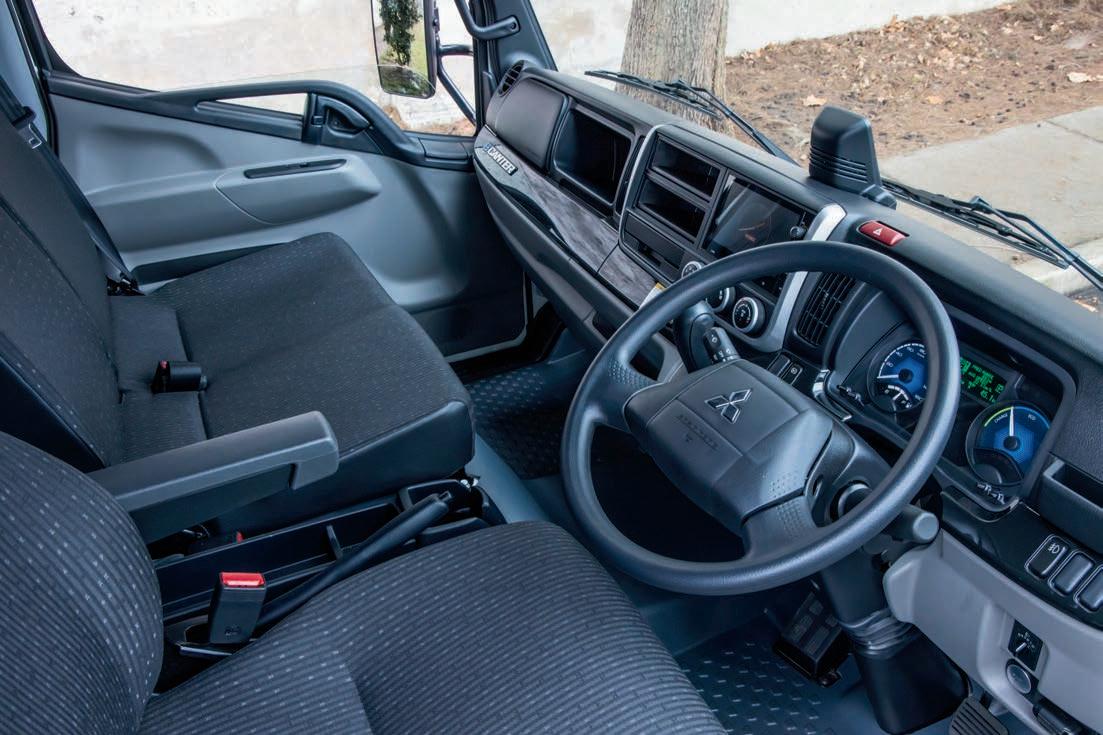
Canter’s cab has been significantly improved over the years but in the electric version, driving ease is brilliant. Still, it’s worth paying attention to the dash readout, particularly regarding driving range









